HONDA PRELUDE 2000 (in English) Manual PDF
Manufacturer: HONDA, Model Year: 2000, Model line: PRELUDE, Model: HONDA PRELUDE 2000Pages: 293, PDF Size: 3.43 MB
Page 71 of 293
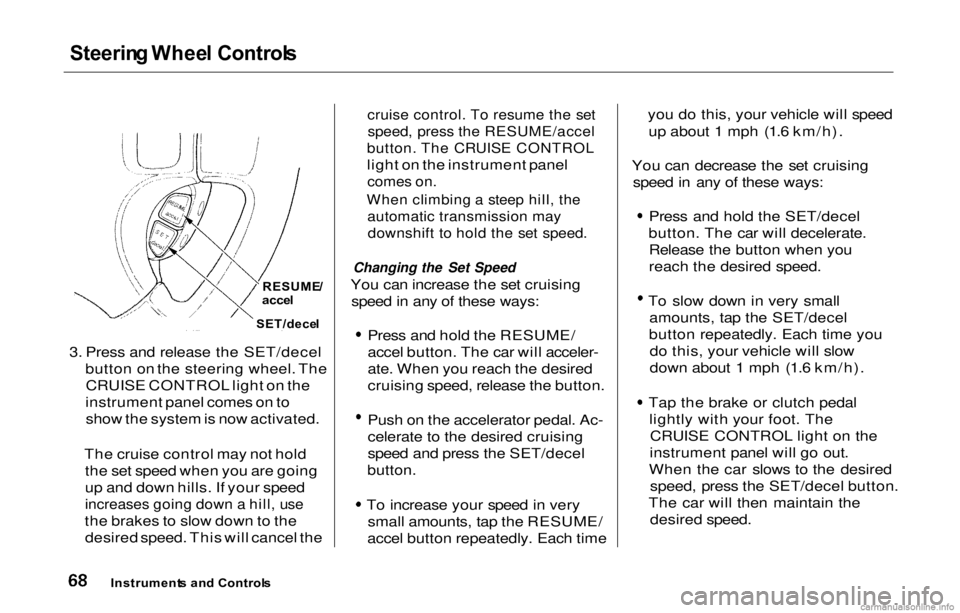
Steerin
g Whee l Control s
3. Press and release the SET/decel button on the steering wheel. TheCRUISE CONTROL light on the
instrument panel comes on to show the system is now activated.
The cruise control may not hold the set speed when you are going
up and down hills. If your speed
increases going down a hill, use
the brakes to slow down to the desired speed. This will cancel the
cruise control. To resume the set
speed, press the RESUME/accel
button. The CRUISE CONTROL
light on the instrument panel
comes on.
When climbing a steep hill, the
automatic transmission may
downshift to hold the set speed.
Changing the Set Speed
You can increase the set cruising speed in any of these ways: Press and hold the RESUME/
accel button. The car will acceler-
ate. When you reach the desired
cruising speed, release the button.
Push on the accelerator pedal. Ac-
celerate to the desired cruising
speed and press the SET/decel
button.
To increase your speed in very
small amounts, tap the RESUME/
accel button repeatedly. Each time you do this, your vehicle will speed
up about 1 mph (1.6 km/h).
You can decrease the set cruising speed in any of these ways: Press and hold the SET/decel
button. The car will decelerate. Release the button when you
reach the desired speed. To slow down in very small
amounts, tap the SET/decel
button repeatedly. Each time you do this, your vehicle will slow
down about 1 mph (1.6 km/h).
Tap the brake or clutch pedal lightly with your foot. TheCRUISE CONTROL light on the
instrument panel will go out.
When the car slows to the desired speed, press the SET/decel button.
The car will then maintain the desired speed.
Instrument s an d Control s
RESUME
/
acce l
SET/dece l
Page 72 of 293

Steerin
g Whee l Control s
Even with the cruise control turned on, you can still use the accelerator
pedal to speed up for passing. After
completing the pass, take your foot off the accelerator pedal. The car
will return to the set cruising speed.
Resting your foot on the brake or
clutch pedal will cause the cruise
control to cancel. Cancelling the Cruise Control
You can cancel the cruise control in any of these ways:
Tap the brake or clutch pedal.Press the SET/decel and RE-
SUME/accel buttons at the same
time.
Press the Cruise Control Master
Switch.
When you tap the brake or clutch pedal, or press the SET and RE-
SUME buttons at the same time, theCRUISE CONTROL light on the
instrument panel will go out and the
car will begin to slow down. You can
use the accelerator pedal in the
normal way.
The system remembers the previously-set cruising speed. To
return to that speed, accelerate toabove 25 mph (40 km/h) and press
the RESUME/accel button until the
CRUISE CONTROL light comes on.
The car will accelerate to the same cruising speed as before.
Pressing the Cruise Control Master
Switch turns the system completelyoff and erases the previous cruising
speed from memory. To use the
system again, refer to Using the
Cruise Control.
Instrument s an d Control s
Page 73 of 293
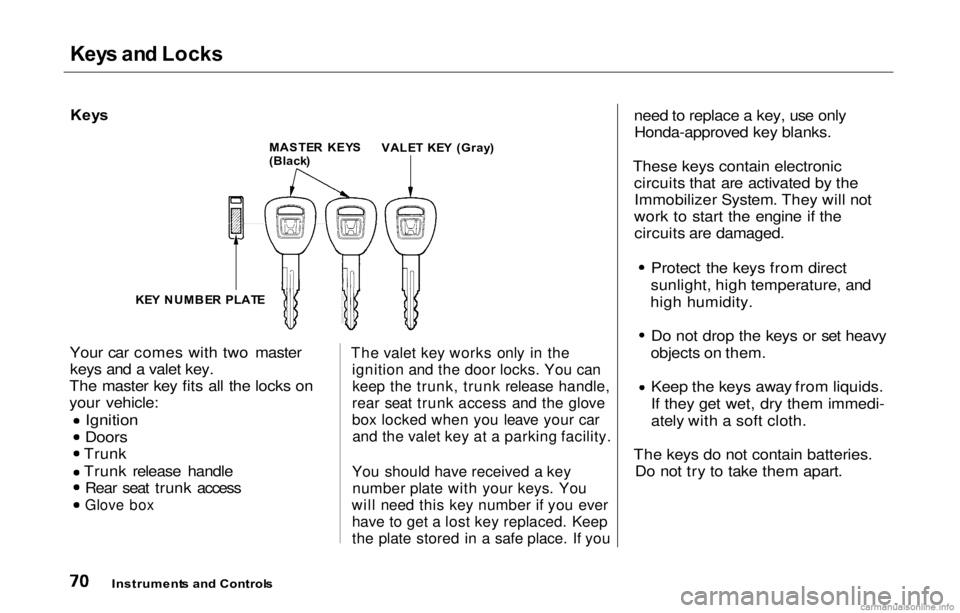
Key
s an d Locks
Key s
Your car comes with two master keys and a vale
t key.
Th
e master key fits all the locks on
your vehicle:
Ignition
Doors
Trunk
Trunk release handle Rear seat trunk access
Glove box
The valet key works only in the
ignition and the door locks. You cankeep the trunk, trunk release handle,
rear seat trunk access and the glove
box locked when you leave your car and the valet key at a parking facility.
You should have received a key number plate with your keys. You
will need this key number if you ever have to get a lost key replaced. Keep
the plate stored in a safe place. If you
need to replace a key, use only
Honda-approved key blanks.
These keys contain electronic circuits that are activated by theImmobilizer System. They will not
work to start the engine if the circuits are damaged. Protect the keys from direct
sunlight, high temperature, and
high humidity. Do not drop the keys or set heavy
objects on them. Keep the keys away from liquids.
If they get wet, dry them immedi-
ately with a soft cloth.
The keys do not contain batteries. Do not try to take them apart.
Instrument s an d Control s
MASTE
R KEY S
(Black ) VALE
T KE Y (Gray )
KE Y NUMBE R PLAT E
Page 74 of 293
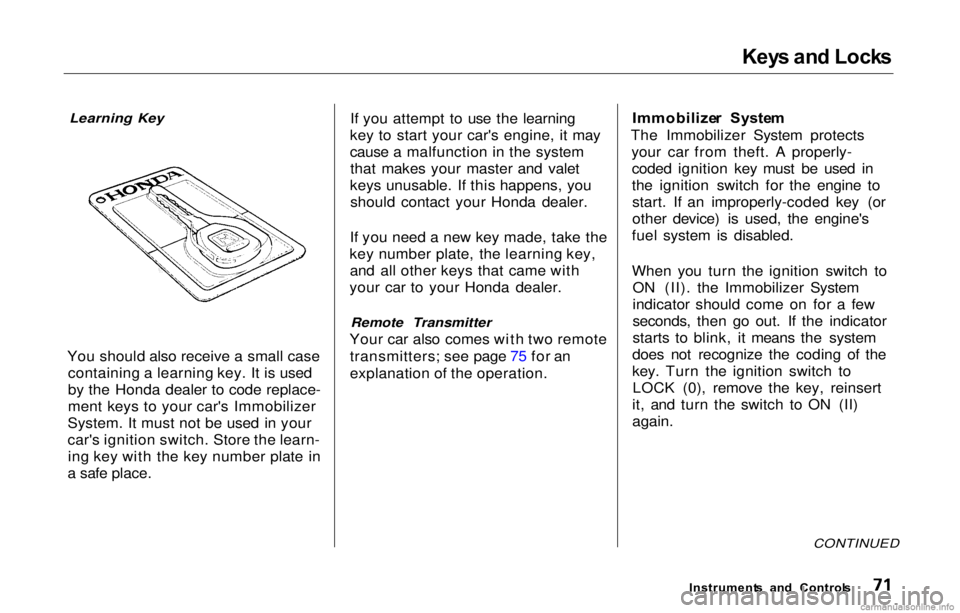
Key
s an d Lock s
Learning Key
You should also receive a small case containing a learning key. It is used
by the Honda dealer to code replace-
ment keys to your car's Immobilizer
System. It must not be used in your
car's ignition switch. Store the learn- ing key with the key number plate in
a safe place. If you attempt to use the learning
key to start your car's engine, it may
cause a malfunction in the system that makes your master and valet
keys unusable. If this happens, you should contact your Honda dealer.
If you need a new key made, take the
key number plate, the learning key, and all other keys that came with
your car to your Honda dealer.
Remote Transmitter
Your car also comes with two remote transmitters; see page 75 for an
explanation of the operation. Immobilize
r Syste m
The Immobilizer System protects your car from theft. A properly-coded ignition key must be used in
the ignition switch for the engine tostart. If an improperly-coded key (or
other device) is used, the engine's
fuel system is disabled.
When you turn the ignition switch to ON (II). the Immobilizer System
indicator should come on for a few
seconds, then go out. If the indicator
starts to blink, it means the system
does not recognize the coding of the
key. Turn the ignition switch to LOCK (0), remove the key, reinsert
it, and turn the switch to ON (II)
again.
CONTINUED
Instrument s an d Control s
Page 75 of 293

Key
s an d Lock s
This indicator will also blink several times when you turn the ignitionswitch from ON (II) to ACCESSORY (I) or LOCK (0).
The system may not recognize your key's coding if another immobilizer
key or other metal object is near the
ignition switch when you insert the
key. To make sure the system
recognizes the key code:
Do not keep other immobilizer
keys on the same key ring. Use a plastic or leather key fob,
not metal.
Keep other keys away from your
vehicle's key and the ignition switch while trying to start the
engine. If the system repeatedly does not
recognize the coding of your key,
contact your Honda dealer.
Do not attempt to alter this system
or add other devices to it. Electrical
problems could result that may make
your car undriveable.
If you have lost your key and you
cannot start the engine, contact your
Honda dealer. As required by the FCC:
This device complies with Part 15 of the
FCC rules. Operation is subject to the
following two conditions: (1) This device
way not cause harmful interference, and (2) this device must accept any
interference received, including
interference that may cause undesired operation.
Changes or modifications not expressly
approved by the party responsible for compliance could void the user's
authority to operate the equipment.
This device complies with Industry
Canada Standard RSS-210.
Operation is subject to the following two
conditions: (1) this device may not cause
interference, and (2) this device must
accept any interference that may cause undesired operation of the device.
Instrument s an d Control s
Page 76 of 293
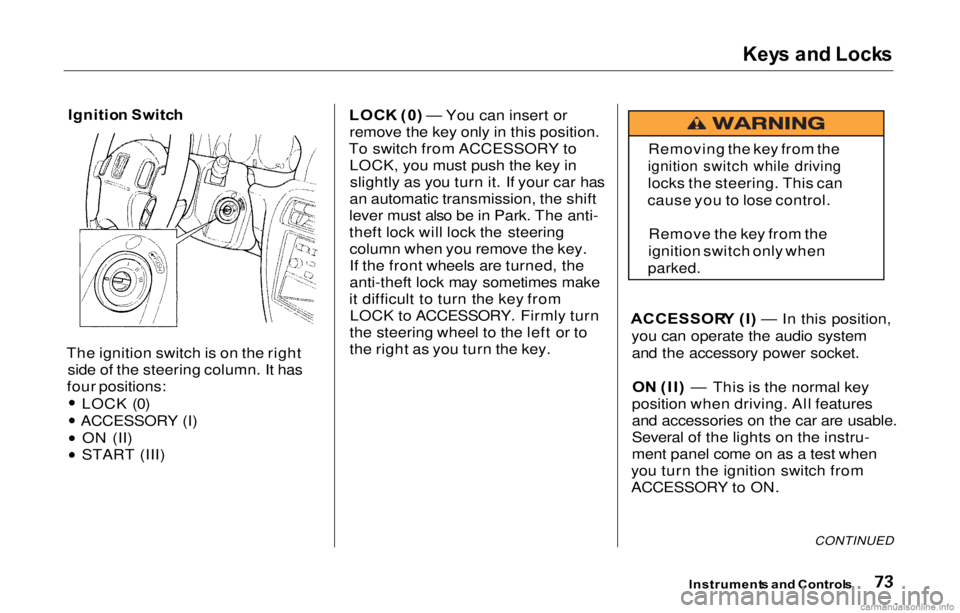
Key
s an d Lock s
Ignitio n Switc h
The ignition switch is on the right side of the steering column. It has
four positions:
LOCK (0)
ACCESSORY (I) ON (II)
START (III) LOC
K (0 ) — You can insert or
remove the key only in this position.
To switch from ACCESSORY to LOCK, you must push the key inslightly as you turn it. If your car has
an automatic transmission, the shift
lever must also be in Park. The anti-
theft lock will lock the steering column when you remove the key.
If the front wheels are turned, the
anti-theft lock may sometimes make
it difficult to turn the key from LOCK to ACCESSORY. Firmly turn
the steering wheel to the left or to
the right as you turn the key. ACCESSOR
Y (I ) — In this position,
you can operate the audio system and the accessory power socket.
O N (II ) — This is the normal key
position when driving. All features
and accessories on the car are usable.
Several of the lights on the instru-
ment panel come on as a test when
you turn the ignition switch from
ACCESSORY to ON.
CONTINUED
Instrument s an d Control s
Removing the key from the
ignition switch while driving
locks the steering. This can
cause you to lose control.
Remove the key from the
ignition switch only when
parked.
Page 77 of 293
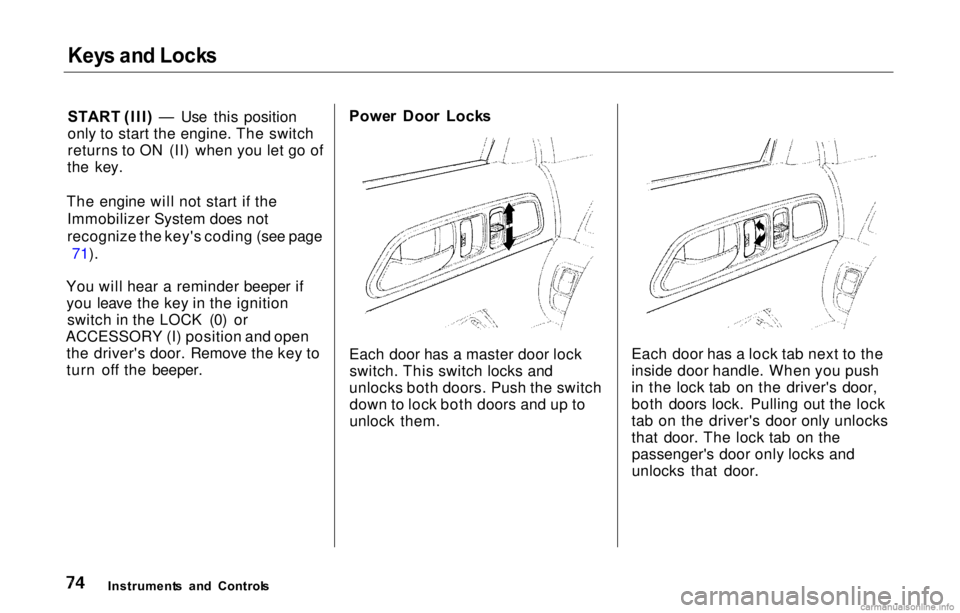
Key
s an d Lock s
START (III ) — Use this position
only to start the engine. The switch
returns to ON (II) when you let go of
the key.
The engine will not start if the Immobilizer System does not
recognize the key's coding (see page 71).
You will hear a reminder beeper if you leave the key in the ignition switch in the LOCK (0) or
ACCESSORY (I) position and open the driver's door. Remove the key to
turn off the beeper. Powe
r Doo r Lock s
Each door has a master door lock switch. This switch locks and
unlocks both doors. Push the switch down to lock both doors and up to
unlock them. Each door has a lock tab next to the
inside door handle. When you push
in the lock tab on the driver's door,
both doors lock. Pulling out the lock
tab on the driver's door only unlocks
that door. The lock tab on the
passenger's door only locks and
unlocks that door.
Instrument s an d Control s
Page 78 of 293
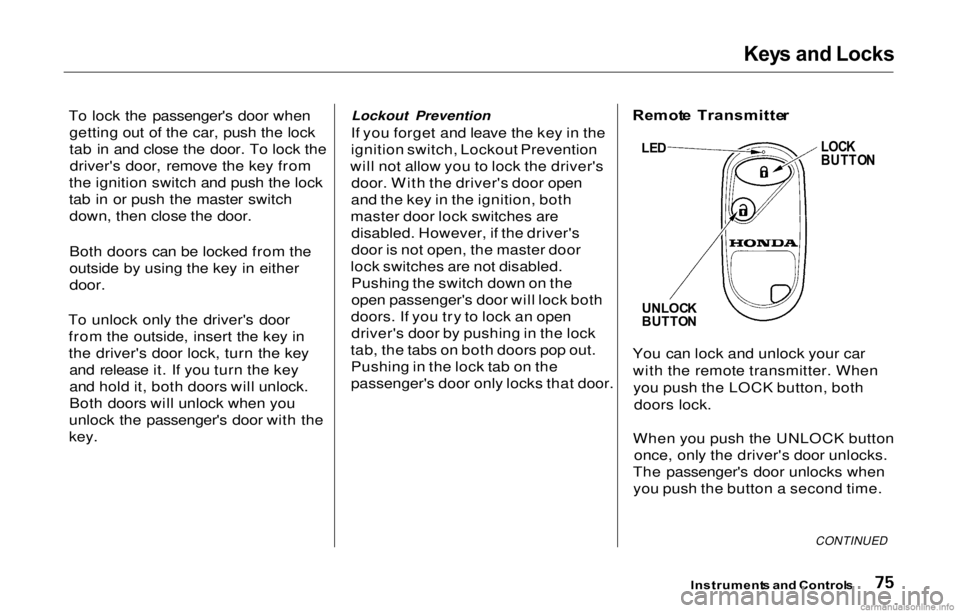
Key
s and Locks
To lock the passenger'
s doo
r when
getting out of the car, push the lock
tab in and close the door. To lock the driver's door, remove the key from
the ignition switch and push the lock
tab in or push the master switch down, then close the door.
Both doors can be locked from the
outside by using the key in either
door.
To unlock only the driver's door from the outside, insert the key in
the driver's door lock, turn the key and release it. If you turn the key
and hold it, both doors will unlock.
Both doors will unlock when you
unlock the passenger's door with the
key. Lockout Prevention
If you forget and leave the key in the
ignition switch, Lockout Prevention
will not allow you to lock the driver's door. With the driver's door open
and the key in the ignition, both
master door lock switches are disabled. However, if the driver's
door is not open, the master door
lock switches are not disabled. Pushing the switch down on the
open passenger's door will lock both
doors. If you try to lock an open driver's door by pushing in the lock
tab, the tabs on both doors pop out. Pushing in the lock tab on the
passenger's door only locks that door. You can lock and unlock your car
with the remote transmitter. Whenyou push the LOCK button, both doors lock.
When you push the UNLOCK button once, only the driver's door unlocks.
The passenger's door unlocks when you push the button a second time.
CONTINUED
Instrument s an d Control s
Remot
e Transmitte r
LOCK
BUTTO N
UNLOC K
BUTTO N
LED
Page 79 of 293
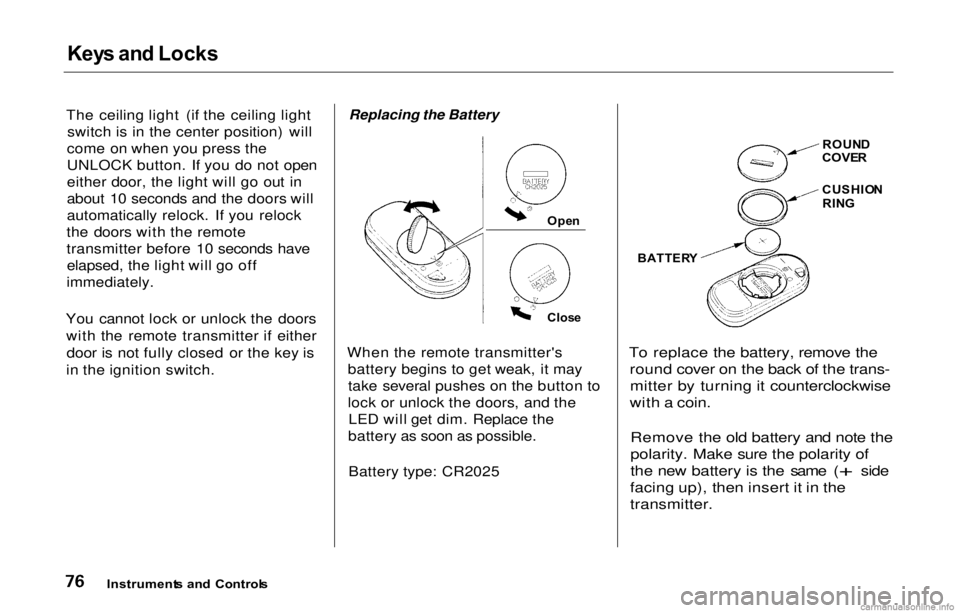
Key
s an d Locks
The ceiling light (if the ceiling light switch is in the center position) will
come on when you press the
UNLOCK button. If you d
o not open
either door, the light will go out in
about 10 seconds and the doors will
automatically relock. If
you reloc
k
the doors with the remote
transmitter before 10 seconds have elapsed, the light will go off
immediately.
You cannot lock or unlock the doors with the remote transmitter if eitherdoor is not fully closed or the key is
in the ignition switch.
Replacing the Battery
When the remote transmitter's battery begins to get weak, it maytake several pushes on the button to
lock or unlock the doors, and the LED will get dim. Replace the
battery as soon as possible.
Battery type: CR2025
To replace the battery, remove the
round cover on the back of the trans-mitter by turning it counterclockwise
with a coin.
Remove the old battery and note the
polarity. Make sure the polarity of
the new battery is the same (
+ side
facing up), then insert
it in the
transmitter.
Instrument s an d Control s
Ope
n
Clos e
BATTER
Y
ROUN
D
COVE R
CUSHIO N
RIN G
Page 80 of 293

Key
s an d Lock s
Reinstall the cushion ring. Align the mark on the cover with the
mark on the transmitter,
then set the cover in place and turn it
clockwise.
Transmitter
Care
Avoid severe shock
to the trans-
mitter, such as dropping or throwing
it. Also, protect it from extreme hot or cold temperatures.
Clean the transmitter case with a
soft cloth. Do not use strong
cleaners or solvents
that coul
d harm
the case. Immersing the transmitter in any liquid will harm the trans-
mitter and cause it to not function
properly.
If you lose a transmitter, you will
need to have the replacement
programmed to your car's system by
your Honda dealer. Any other
transmitters you have will also need
to be reprogrammed. As required by the FCC:
This device complies with Part 15 of the
FCC rules. Operation is subject to the
following two conditions: (1) This device may not cause harmful interference, and (2) this device must accept any
interference received, including interference that may cause undesired operation.
Changes or modifications not expressly
approved by the party responsible for compliance could void the user's
authority to operate the equipment.
This device complies with Industry
Canada Standard RSS-210.
Operation is subject to the following two
conditions: (1) this device may not cause
interference, and (2) this device must accept any interference that may cause undesired operation of the device.
Instrument s an d Control s